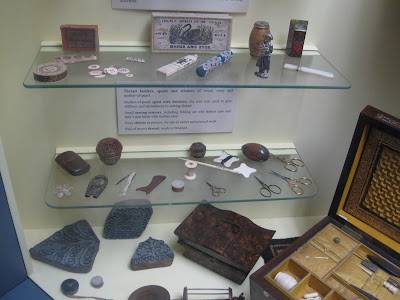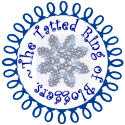 |
| Bodice and skirt from Threads of War |
First of all, the Threads of War was a fairly small exhibit, limited in scope. I was hoping to see lace making or evidence of homemade lace, but saw none. It was mostly clothing items and other large textiles from that era, including coverlets and flags.
But those were very good, and the real deal. Here are some children's garments, with a bit of a slave shirt in the background.
Some Confederate uniforms and flags. The fact that these are in this good shape is pretty phenomenal.
More, including a quilt and nightgown.
Another uniform and a child's bodice. That may be a flag from a Texan unit.
Here are some small items from the exhibit. Can you imagine putting a child in those blue shoes these days?
And some infant items. including a quilted bib. No tatting. I looked.
This is the only sewing/handwork related item in the exhibit. Sigh. I'm sure people tatted. But I love the shoe-shaped pin cushion.
Outside the exhibit, there were other items. including this terrific Victorian doll house.
And some miscellaneous ancient items. Love the Egyptian cat.
There was an exhibit on the lower floor with a lot of small items, including this chatelaine set.
And hair jewelry. Moe was totally grossed out by this. I'm fascinated, but it's not something I would want to touch, much less wear.
The other interesting part of the museum was a large permanent exhibit related to the history of Charleston. Lotsa pictures, furniture, plantation and Civil war items. I'll just give you a few items.
Have you ever seen them talk about pottery by Dave the Slave on the Antiques Road Show? There were 6 or 8 large pots by Dave here. As a potter, I'm impressed. The form is lovely.
And some small cool face jugs. (I also have a collection of face jugs.) I love these!
I found a great little housewife. Look, knitting supplies! And a thread winder!
And finally, finally, deep into the exhibit, I found a grouping with sewing and handwork.
With a gorgeous sewing chest....
And OMG! Actual tatting! And 3 tatting shuttles! Plus crochet hooks and other goodies. It's not a good example of tatting - it look modern and kinda bad - but it is tatting. Success!
And for the Palmetto Tatters, I show you some cool palmettos, made as Confederate patriotic items.
There was more - Moe found a big exhibit of guns that he was delighted with, plus a mock-up of the Hunley - but I'll spare you the moth-eaten polar bear and all the weird animal skeletons. They were too strange.
Next time - Mepkin Abbey.





















.jpeg)

























That's an exhibit I would love to see! The romantic in me would love to wear the long dresses, but the modern me says... to hot and cumbersome! Thanks for sharing your pics!
ReplyDelete...Thank you for the tour! I have a period dress in plan. I have the pattern for 1830's, got the fabric and other needed notions. It is waiting for me. LOL I am waiting for me too!
ReplyDeleteThanks again!
Absolutely fascinating discoveries! Congratulations on some mighty-fine sleuthing.
ReplyDeleteOne question...those three stamps(?) to the left of the sewing box -- do you think the impressed designs were stamped in ink onto fabric and embroidered? They certainly could have been Tatted instead, don't you think?
ReplyDeleteI really enjoyed this "virtual visit" to the museum. I love anything connected to the history of clothing and needlework. I enlarged the pictures 'au maximum' and just drooled. :D Thanks!
ReplyDeleteGreat pictures! I love other people's travel photos -- can't wait to see Mepkin Abbey.
ReplyDeleteReally enjoyed these pictures!!! My family and I used to be Civil War living historians so I did a lot of research on tatting during that time period and one of the reasons that you see so little tatting on display is because it was used quite often on the under garments and handkerchiefs very few articles survived long enough to find there way into museums. Later during the Victorian Era is when they started to use tatting on collars and cuffs. Tatting was very popular during the 1860's and most women carried a tatting bag and I wish they had more of it on display but, sadly during reconstruction much was lost or used for other things.
ReplyDelete